Banksia densa is a species of column-like shrub that is endemic to Western Australia. It has deeply serrated to pinnatifid leaves, creamy yellow flowers in heads of up to seventy-five, and hairy follicles.
Banksia tortifolia is a small, spreading, prostrate shrub that is endemic to the southwest of Western Australia. It has short underground stems, pinnatipartite leaves with sharply-pointed, linear lobes on each side, greenish-cream, yellow and pink flowers in heads of about eighty, and glabrous, egg-shaped follicles.
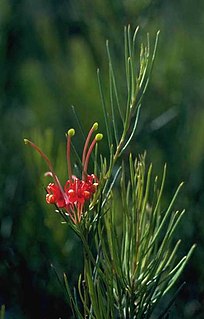
Grevillea acuaria is a species of flowering plant in the family Proteaceae and is endemic to the south-west of Western Australia. It is a rounded, bushy to erect shrub with spreading linear to narrowly elliptic leaves and red flowers arranged in small clusters.

Patersonia sericea, commonly known as purple flag or silky purple-flag is a species of plant in the iris family Iridaceae and is endemic to eastern Australia. It is a densely-tufted perennial herb with linear, sword-shaped leaves, broadly egg-shaped, bluish-violet tepals and an oval capsule.
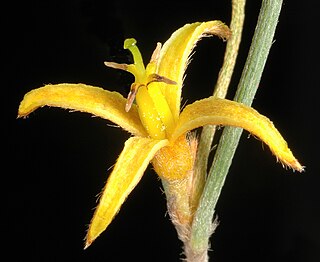
Persoonia angustiflora is a species of flowering plant in the family Proteaceae and is endemic to the south-west of Western Australia. It is an erect shrub with hairy branches and leaves, linear, more or less cylindrical leaves and yellow or greenish yellow flowers arranged singly or in groups of up to four.

Isopogon buxifolius is a species of plant in the family Proteaceae and is endemic to the south-west of Western Australia. It is an upright shrub with egg-shaped to elliptic or oblong leaves and clustered spikes of pink flowers.

Isopogon spathulatus is a species of flowering plant in the family Proteaceae and is endemic to south-western Western Australia. It is a shrub with linear to egg-shaped leaves with the narrower end towards the base, and more or less spherical heads of hairy pink flowers.

Petrophile semifurcata is a species of flowering plant in the family Proteaceae and is endemic to an area near the west coast of Western Australia. It is an erect, bushy shrub with sharply-pointed, needle-shaped, sometimes lobed leaves and oval heads of silky-hairy, whitish, lemon-yellow or cream-coloured flowers.

Calandrinia granulifera is an annual herb in the family Montiaceae, and is native to New South Wales, Tasmania, Western Australia, South Australia, and Victoria.

Goodenia arthrotricha is a species of flowering plant in the family Goodeniaceae and endemic to south-western Western Australia. It is an erect perennial, herb with linear to lance-shaped leaves with the narrower end towards the base, racemes of blue flowers with linear bracteoles at the base, and oval fruit.
Goodenia brachypoda is a species of flowering plant in the family Goodeniaceae and is endemic to northern Australia. It is a low-lying to upright herb with narrow elliptic to oblong leaves, racemes of yellow flowers with leaf-like bracts at the base, and more or less spherical fruit.
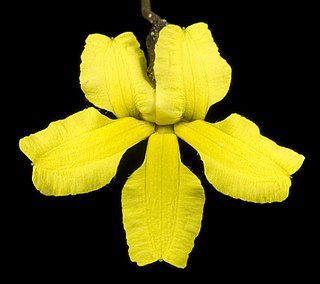
Goodenia concinna is a species of flowering plant in the family Goodeniaceae and endemic to coastal area of southern Western Australia. It is a perennial, herb with linear to lance-shaped leaves, and racemes of yellow or cream-coloured flowers.
Goodenia leptoclada, commonly known as thin-stemmed goodenia, is a species of flowering plant in the family Goodeniaceae and is endemic to the extreme south-west of Western Australia. It is an ascending perennial herb with lance-shaped to egg-shaped leaves with the narrower end towards the base and racemes of blue flowers.
Goodenia trichophylla is a species of flowering plant in the family Goodeniaceae and is endemic to the southwest of Western Australia. It is an erect to ascending herb with sticky or shiny, linear leaves at the base of the plant and racemes of blue flowers.

Hibbertia polystachya is a species of flowering plant in the family Dilleniaceae and is endemic to the south-west of Western Australia. It is an erect to sprawling or straggly shrub with narrow elliptic to linear leaves and yellow flowers arranged in groups of up to five with about ten stamens and a similar number of staminodes, arranged on one side of two hairy carpels.
Patersonia argyrea is a species of plant in the iris family Iridaceae and is endemic to Western Australia. It is a tufted perennial herb with linear, sword-shaped leaves and violet tepals.
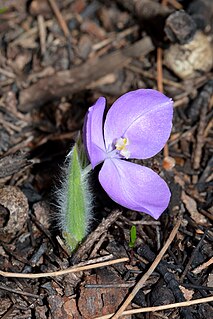
Patersonia babianoides is a species of plant in the iris family Iridaceae and is endemic to the south-west of Western Australia. It is a tufted, rhizome-forming herb with soft, linear to elliptic leaves and blue-violet tepals on a relatively short flowering scape.
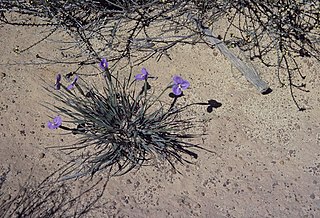
Patersonia drummondii, commonly known as Drummond's patersonia, is a species of plant in the iris family Iridaceae and is endemic to the south-west of Western Australia. It is a tufted herb with linear, often twisted leaves and pale violet to purple or blue tepals.

Patersonia graminea, commonly known as grass-leaved patersonia, is a species of plant in the iris family Iridaceae and is endemic to the south-west of Western Australia. It is a clump-forming herb with linear, grass-like leaves and pale violet tepals.
Patersonia juncea, commonly known as rush leaved patersonia, is a species of plant in the iris family Iridaceae and is endemic to a restricted part of the south-west of Western Australia. It is a tufted perennial herb with linear leaves and pale violet tepals.













